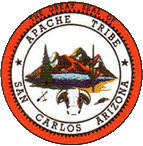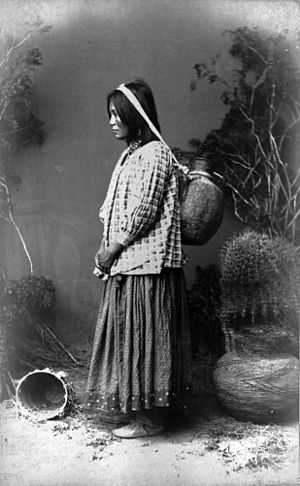Western Apache people facts for kids
The Western Apache are a group of Native American people who mostly live in east-central Arizona, in the United States. Most of them live on special lands called reservations. The main reservations for Western Apache people are the Fort Apache Indian Reservation, San Carlos Apache Indian Reservation, Yavapai-Apache Nation, Tonto Apache, and the Fort McDowell Yavapai Nation. These are also the homes of their federally recognized tribes.
The Western Apache people call themselves Ndee (Indé) which means “The People.” Some groups, like the Pinaleño/Pinal and Arivaipa/Aravaipa bands of the San Carlos Apache, say the word a bit differently, like Innee or Nnēē:.

Contents
Language and Culture of the Western Apache
The Western Apache people speak their own language, which they call Ndee biyati' / Nnee biyati. This language is part of the Southern Athabaskan language family. The Navajo people speak a similar language, but they separated from the Apache many years ago. Other groups who speak Athabaskan languages live far away in Alaska and Canada.
A researcher named Grenville Goodwin once said there were five main groups of Western Apache based on their language and culture. These were:
- Cibecue
- Northern Tonto
- Southern Tonto
- San Carlos
- White Mountain
Later, other researchers agreed that there are three main Apache dialects, with smaller groups within them:
- San Carlos
- White Mountain
- Dilzhe'e (Tonto)
Today, about 20,000 Western Apache people still speak their native language. The tribes are working hard to keep their language alive. They use teachers who speak both Apache and English in schools. This helps children learn their traditional language. However, many children also learn English, and sometimes Spanish, depending on their families.
In terms of culture, tribal schools teach many traditional skills. Students learn how to make baskets, bows, arrows, spears, and shields. They also learn to make special cradles for babies. Girls and young women learn to create traditional clothing and items from buckskin. They also learn how to make beautiful silver jewelry. Young men often learn to make jewelry too.
Western Apache Bands and Tribes
The Western Apache are made up of several important groups, often called "bands" or "tribes." Each group has its own history and traditional lands.
White Mountain Apache
The White Mountain Apache call themselves Dził Łigai Si'án N'dee, which means "People of the White Mountains." They live mostly on the Fort Apache Indian Reservation. This group is the most eastern of the Western Apache. Their traditional lands stretched from the White Mountains to the Gila Mountains and Pinaleno Mountains. They often lived near rivers like the White River, Turkey Creek, Black River, and the Gila River, which they used for farming.
Cibecue Apache
The Cibecue Apache are named after the Cibecue Creek Valley. Their Apache name, Dishchiiʼ Bikoh, means "Horizontally Red Canyon." They lived north of the Salt River up to the Mogollon Rim. This area included places like Cherry Creek and Cedar Creek. Today, many Cibecue Apache are part of the White Mountain Apache tribe on the Fort Apache Reservation.
San Carlos Apache of the San Carlos Reservation
The San Carlos Apache call themselves Tsékʼáádn, meaning "Metate People" (a metate is a tool for grinding grain). They lived near the San Pedro River and in the foothills of the Santa Catalina Mountains near Tucson. This is a federally recognized tribe. It includes the San Carlos Apache themselves, plus some groups from the Cibecue Apache, Tonto Apache, Lipan, and Chiricahua Apache peoples.
Some of their main groups include:
- Apache Peaks band: These people were sometimes called "Spoiled Mescal People." They lived northeast of Globe, between the Salt River and the Apache Peaks.
- San Carlos band: Also known as "Metate People," they lived and farmed along the San Carlos River.
- Pinaleño/Pinal band: Their name comes from Spanish for "Pinery People" (pine forest). They lived in the Pinaleno Mountains and farmed along Pinal Creek.
- Arivaipa/Aravaipa band: They called themselves "Dark Rocks People." Their lands included the Aravaipa Creek Valley and the Galiuro Mountains.
Tonto Apache
The Tonto Apache call themselves Dilzhé`e. They lived across a wide area, from the San Francisco Peaks to the Mazatzal Mountains and the Salt River. They were the most western group of the Western Apache.
Other Apache groups sometimes called them Koun`nde, meaning "Those who you don’t understand" or "wild rough People." The Spanish later used the word Tonto, which means 'foolish' in Spanish. The Navajo people called them Dilzhʼíʼ dinéʼiʼ, meaning "People with high-pitched voices," because of how they spoke.
The Tonto Apache are divided into two main groups:
- Northern Tonto: They lived in the upper parts of the Verde River and north towards the San Francisco Peaks. They often shared hunting grounds with the Yavapai people, forming mixed groups with leaders from both tribes.
- Southern Tonto: They lived in the Tonto Basin, including the Sierra Ancha and Mazatzal Mountains. Like the Northern Tonto, they also formed mixed groups with Yavapai people.
Notable Western Apache People
Many important leaders and figures have come from the Western Apache tribes.
White Mountain Apaches
- Alchesay (1853–1928): Also known as "The Little One," Alchesay was a chief of the White Mountain Apache and an Apache Scout. He received the Medal of Honor for his bravery during the Apache and Yavapai Wars. He tried to convince Geronimo to surrender peacefully. Later, he became a successful rancher and worked to help Native American communities.
- Bylas: Known as "One Who Does All the Talking," Bylas was a chief of the Eastern White Mountain band. The town of Bylas on the San Carlos Reservation is named after him.
- Esh-kel-dah-sila (around 1850–1875): This chief was known as "He Is Constantly Angry." He was a very respected leader of the Eastern White Mountain Apache. He made alliances with the Hopi and Zuni tribes. He also allowed a military camp, which later became Fort Apache, to be built on White Mountain Apache land.
Cibecue Apache
- Miguel (died 1871): Also called "One-Eyed-Miguel," he was a chief of the Carrizo band. In the late 1860s, he helped start relations between the Apache and Americans, leading to the creation of Fort Apache. He also helped recruit the first Apache Scouts.
- Pedro (around 1835–1885): Known as "Angry, He Ask for It," Pedro was a chief of the Carrizo band. He was a constant friend to the Americans. His group intermarried with the White Mountain Apaches and were often considered part of that tribe.
- Nock-ay-det-klinne (died 1881): He was a chief and respected medicine man of the Cañon Creek band. He held dances and claimed he could bring dead chiefs back to life. The Army tried to arrest him, which led to the Battle of Cibecue Creek. This battle caused a larger Apache uprising involving leaders like Geronimo.
San Carlos Apaches
- Casador: Known as "Great Chief," Casador was recognized as the main chief of the San Carlos band.
- Santo: An Arivaipa Apache Chief and spiritual leader, he was the father-in-law of another important leader, Eskiminzin.
Tonto Apaches
- For more information on Tonto Apache chiefs, you can look at the main article about the Tonto Apache.



